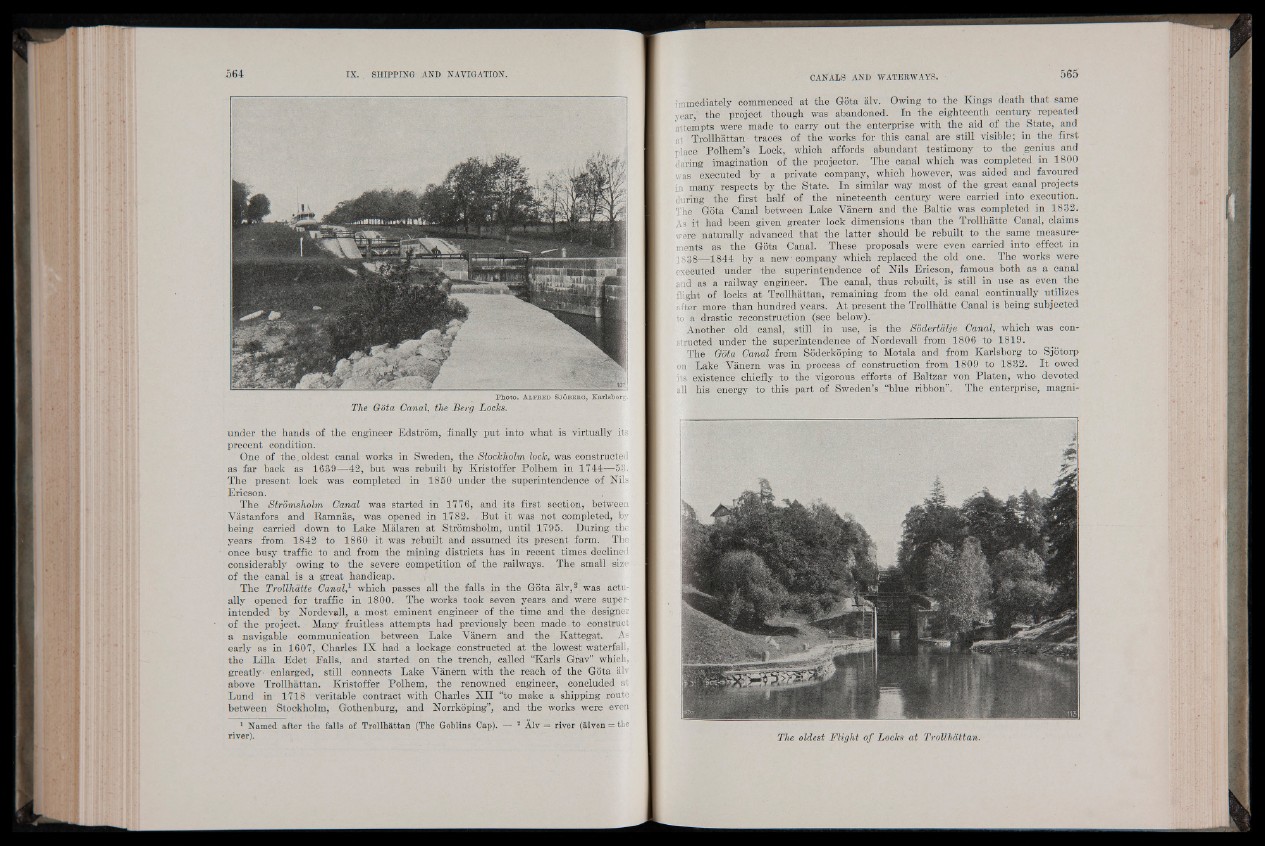
P h o to . Al f r e d Sj Ob e r g , K a rlsb o rg .
The Goto, Canal, the Berg Locks.
under the hands of the engineer Edstrom, finally put into what is virtually its
precent condition.
One of the. oldest canal works in Sweden, the Stockholm lock, was constructed
as far back as 1639—42, but .was rebuilt by Kristoffer Polhem in 1744 -53.
The present lock was completed in 1850 under the superintendence. of Nils
Ericson.
The Stromsholm Canal was started in 1776, and its first section, between
Vastanfors and Bananas, was opened in 1782. , But it was not completed, by
being carried down to Lake Malaren at Stromsholm, until 1.795. During the
years from 1842 to 1860 it was rebuilt and assumed its present form. The
once busy traffic to and from the mining districts has in recent times declined
considerably owing to the severe competition of the railways. The small size
of the canal is a great handicap.
The Trollhdtte Canal,1 which passes all the falls in the Gota alv,2 was actually
opened for traffic in 1800. The works took seven years and were superintended'
by Nordevall, a most eminent engineer of the time and the designer
of the project. Many fruitless attempts had previously been made to construct
a navigable communication between Lake Vanern and the Kattegat. As
early as in 1607, Charles IX had a lockage constructed at the lowest waterfall,
the Lilia Edet Falls, and started on the trench, called “Karls Grav” which,
greatly- enlarged, still connects Lake Vanern with the reach of the Gota alv
above Trollhattan. Kristoffer Polhem, the renowned engineer, concluded at
Lund in 1718 veritable contract with Charles XII “to make a shipping route
between Stockholm, Gothenburg, and Norrkoping”, and the works were even
1 Named after the falls of Trollhattan (The Goblins Cap). — 2 Alv = river (alven = the
river).
immediately commenced at the Gota alv. Owing to the Kings death that same
year,' the project though was abandoned. In the eighteenth century repeated
attempts were made to carry out the enterprise with the aid of the State, and
at Trollhattan- traces of the works for this canal are still visible; in the first
place Polhem’s Lock, which affords abundant testimony to the genius and
daring imagination of the projector. The canal which was completed in 1800
was executed by a private company, which however, was aided and favoured
in many respects by the State. In similar way most of the great canal projects
during the first half of the nineteenth century were carried into execution.
The Gota Ganal between Lake Vanern and the Baltic was completed in 1832.
As it had' been given greater lock dimensions than the Trollhatte Canal, claims
were naturally advanced that the latter should be rebuilt to the same measurements
as the Gota Canal. These proposals were even carried into .effect in
1838J—1844 by a new-company which replaced the old one. The works were
executed under th e superintendence of Nils Ericson, famous both as a canal
and as a railway engineer. The canal, thus rebuilt, is still in use as even the
flight of locks at Trollhattan, remaining from the old canal continually utilizes
after more than hundred years. At present the Trollhatte Canal is being subjected
to a drastic reconstruction (see below).
Another old canal, still in use, is the Sodertalje Canal, which was constructed
under the superintendence of Nordevall from 1806 to 1819.
The Gota Canal from Soderkoping to Motala and from Karlsborg to Sjotorp
on (Lake "Vanern was in process of construction from 1809 to 1832. I t owed
its existence chiefly to the vigorous efforts of Baltzar von Platen, who devoted
all his energy to this part of Sweden’s “blue ribbon”. The enterprise, magni-
The oldest Flight o f Locks at Trollhattan.